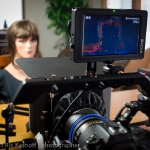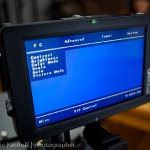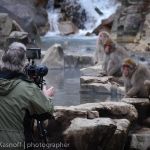 For years as a professional still photographer I’ve found myself peering at and through many different types of devices in an attempt to accurately frame my shots. From 35mm camera viewfinders to medium format “action” finders and the upside down and backwards ground glass of a 4×5, it seems like I’ve spent countless hours squinting or contorting into awkward positions just to see what I’m trying to shoot.
For years as a professional still photographer I’ve found myself peering at and through many different types of devices in an attempt to accurately frame my shots. From 35mm camera viewfinders to medium format “action” finders and the upside down and backwards ground glass of a 4×5, it seems like I’ve spent countless hours squinting or contorting into awkward positions just to see what I’m trying to shoot.
Never has this crucial part of the image making process been as pleasant and productive as it has been since I acquired my smallHD Dp6 monitor.
The adoption of “convergence” shooting with my Nikon D7000’s once again led me down the road of trying to figure out how to most efficiently see what I was trying to capture. From the small LCD screen on the back of the camera to a loupe attached with high priced rubber bands I experimented with a few different methods of viewing before I discovered what I think is the best solution for both still and video shooting from the HDslr’s…The smallHD Dp6.
 At approximately 5.6” corner to corner the Dp6 significantly adds to the 3” viewing areas of most HDslrs but that’s just the start. Along with the increase in screen real estate you get true HD output (1280×800) that’s bright enough to see outdoors and a host of “modes” to assist you in your image making. The available functions in the menu run the gamut from customizable image scaling to RGB color controls and 1:1 pixel mapping to the two I find most usefull to me, focus assist and false colors.
At approximately 5.6” corner to corner the Dp6 significantly adds to the 3” viewing areas of most HDslrs but that’s just the start. Along with the increase in screen real estate you get true HD output (1280×800) that’s bright enough to see outdoors and a host of “modes” to assist you in your image making. The available functions in the menu run the gamut from customizable image scaling to RGB color controls and 1:1 pixel mapping to the two I find most usefull to me, focus assist and false colors.
 Now this may not seem like a big deal to those who come from the video world and are used to these features, but being primarily a still shooter and hitting that age where my eyeglass prescription number tends to inch it’s way up faster and faster, having a push button feature that brightly outlines the in focus parts of an image is a real godsend, especially with the narrow depth of field we tend to shoot these cameras at. I’m finding the feature invaluable for pulling focus on normal as well as slider shots (whoops…I mean “Linear Tracking Shots”…I am using Cinevate equipment after all ;-).
Now this may not seem like a big deal to those who come from the video world and are used to these features, but being primarily a still shooter and hitting that age where my eyeglass prescription number tends to inch it’s way up faster and faster, having a push button feature that brightly outlines the in focus parts of an image is a real godsend, especially with the narrow depth of field we tend to shoot these cameras at. I’m finding the feature invaluable for pulling focus on normal as well as slider shots (whoops…I mean “Linear Tracking Shots”…I am using Cinevate equipment after all ;-).
 The other mode I use and really appreciate on all of my shoots is the various flavors of “false colors” they’ve implemented. Tied to the IRE scale this mode lets you see at a glance if you’re inadvertently crushing blacks or blowing highlights by assigning bright, easily recognizable colors to different parts of the exposure range.
The other mode I use and really appreciate on all of my shoots is the various flavors of “false colors” they’ve implemented. Tied to the IRE scale this mode lets you see at a glance if you’re inadvertently crushing blacks or blowing highlights by assigning bright, easily recognizable colors to different parts of the exposure range.
The ability to assign these modes to two quick function buttons on the top of the monitor makes them accessible and ensures I’ll be able to quickly and easily use them when needed. Now this isn’t to imply that getting to the dozens of features available in the main menus is hard but it does take learning a new approach to accessing and navigating menus.
 When I first tried to access the menus and customize the settings I found I was trying to overcomplicate things. Getting the relationship between the clickable (or not…depending on where you want to go) scroll wheel and the two function buttons took a little while to sink in but when I finally “got it” (by finally watching their online instructional videos…duhh ;-) I realized that they had devised a simple and elegant way to combine the functionality of each and thereby reduce the normal button clutter you’ll see on other monitors. Minimizing the number of controls also allowed the placement of the buttons/wheel at the top-outside of the monitor where they are always easily accessible.
When I first tried to access the menus and customize the settings I found I was trying to overcomplicate things. Getting the relationship between the clickable (or not…depending on where you want to go) scroll wheel and the two function buttons took a little while to sink in but when I finally “got it” (by finally watching their online instructional videos…duhh ;-) I realized that they had devised a simple and elegant way to combine the functionality of each and thereby reduce the normal button clutter you’ll see on other monitors. Minimizing the number of controls also allowed the placement of the buttons/wheel at the top-outside of the monitor where they are always easily accessible.
 The overall build quality of the unit with it’s solid aluminum case is impressive and was really proven out in the first PhotoSafari trip with the it to the Snow Monkeys of Japan (see Rigging for Travel). Rain, cold and mist combined with the constant packing and unpacking of the travel shoot didn’t even cause the Dp6 to blink. The included screen guards protected the unit from scratches and most smudges even when quickly putting back into the camera bag without the included neoprene case. The default SmallHD 26Wh batteries life is amazing and seems to last well beyond the 4 hours they claim. I’ve often found myself wondering after a day or two if I shouldn’t just top it off just in case. Another nice touch is the interchangeable battery plates they offer for most common still and video camera batteries that help reduce the charger clutter when traveling.
The overall build quality of the unit with it’s solid aluminum case is impressive and was really proven out in the first PhotoSafari trip with the it to the Snow Monkeys of Japan (see Rigging for Travel). Rain, cold and mist combined with the constant packing and unpacking of the travel shoot didn’t even cause the Dp6 to blink. The included screen guards protected the unit from scratches and most smudges even when quickly putting back into the camera bag without the included neoprene case. The default SmallHD 26Wh batteries life is amazing and seems to last well beyond the 4 hours they claim. I’ve often found myself wondering after a day or two if I shouldn’t just top it off just in case. Another nice touch is the interchangeable battery plates they offer for most common still and video camera batteries that help reduce the charger clutter when traveling.
The only “issues” I’ve been able to find are really just minor ones with input placement for the charger cord and the hiding of the battery power switch under the jumper cables that connect the smallHD default battery to the monitor. My other concern isn’t a smallHD problem but rather the inherent weakness of HDMI cables and the high failure rate I’ve had with them. This I’ve remedied by adding a “swivel” adapter to the camera input and thereby reducing the stress at that point. This also allowed me to switch to using cables with full sized heads on both ends as the adapter also functions as a “step-up” converter from mini to full sized connectors which seem stronger, are more readily available and less expensive in the short 18″ size.
 Over the last 6 months I’ve found it’s lightweight and rugged construction combined with good looks and functionality to be an asset to all of my still and video shoots. Whether in the field or in-studio, by itself on a solo shoot or three at a time like on recent multi-cam shoots, it gives me a clear, bright image and supports the “situational awareness” that’s so critical in identifying what is about to impact the shot. Bottom line is I’m spoiled and I can’t imagine shooting without it.
Over the last 6 months I’ve found it’s lightweight and rugged construction combined with good looks and functionality to be an asset to all of my still and video shoots. Whether in the field or in-studio, by itself on a solo shoot or three at a time like on recent multi-cam shoots, it gives me a clear, bright image and supports the “situational awareness” that’s so critical in identifying what is about to impact the shot. Bottom line is I’m spoiled and I can’t imagine shooting without it.
With all of the sub $500.00 monitors available now the price of $899.00 ($1,299.00 w/ SDI) may cause some to pause, but I think of it like my lenses. I buy great glass once and it lasts me for years, far longer than any camera body I’ve owned. The same principle applies here as the Dp6 gives me HD output that exceeds my current cameras capabilities and is updatable via the USB port. Wes, Dale and Reed Phillips the owners (who are award winning film makers as well as being just flat out nice guys) are constantly reviewing user feedback and their own experience then adding firmware updates as needed to keep the Dp6 performing as a real professional grade tool and ensure that my investment maintains it’s value and usefulness for years to come.
BTW: it’s a good thing it’s sealed as well as it is because every photographer who sees and experiences mine tends to salivate a bit and I don’t think that’s covered under the warranty.
Enjoy…Ric
Btw: Just had a peek at their latest offering the Dp4 at NAB. Slightly smaller at 4” it has all of the functionality of it’s big brother along with a few nice additions like a battery meter, better switch and jack placement and best of all a swing up loupe that transforms it into a very nice EVF. Can’t wait to get my hands on one for testing when they’re released in May at the very nice price of $599.00 for the monitor and lots of accessories or $799.00 for the full EVF package.
See them at: smallHD‘s website